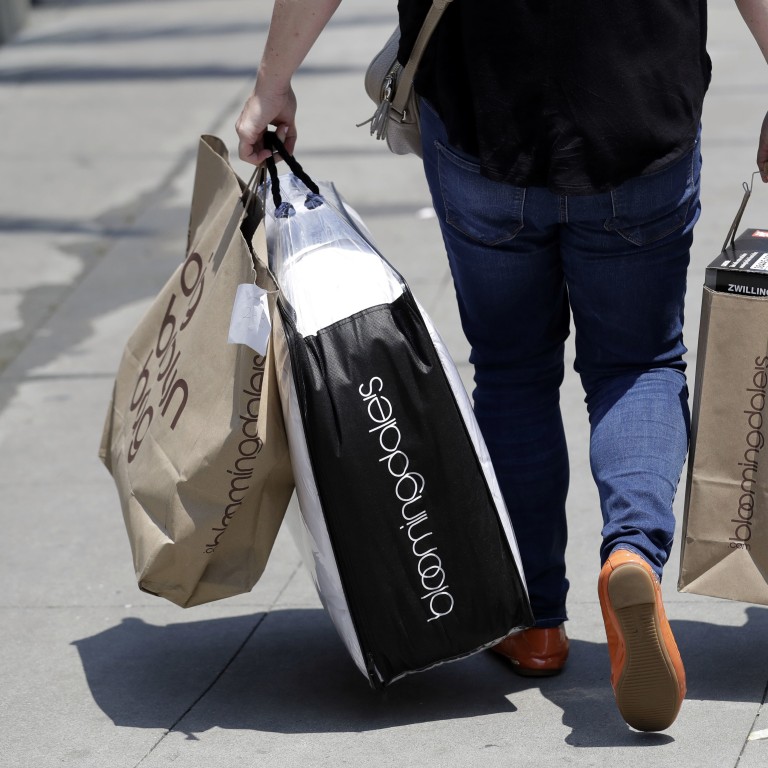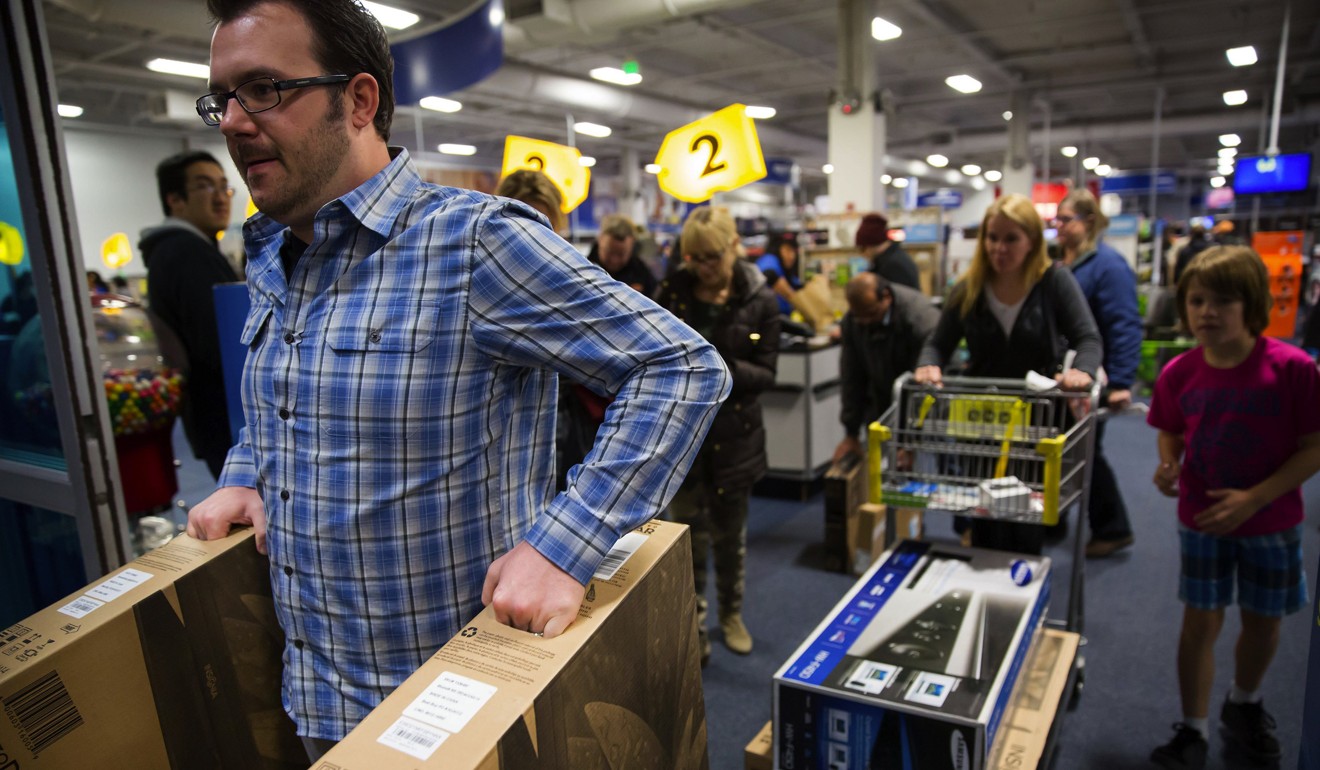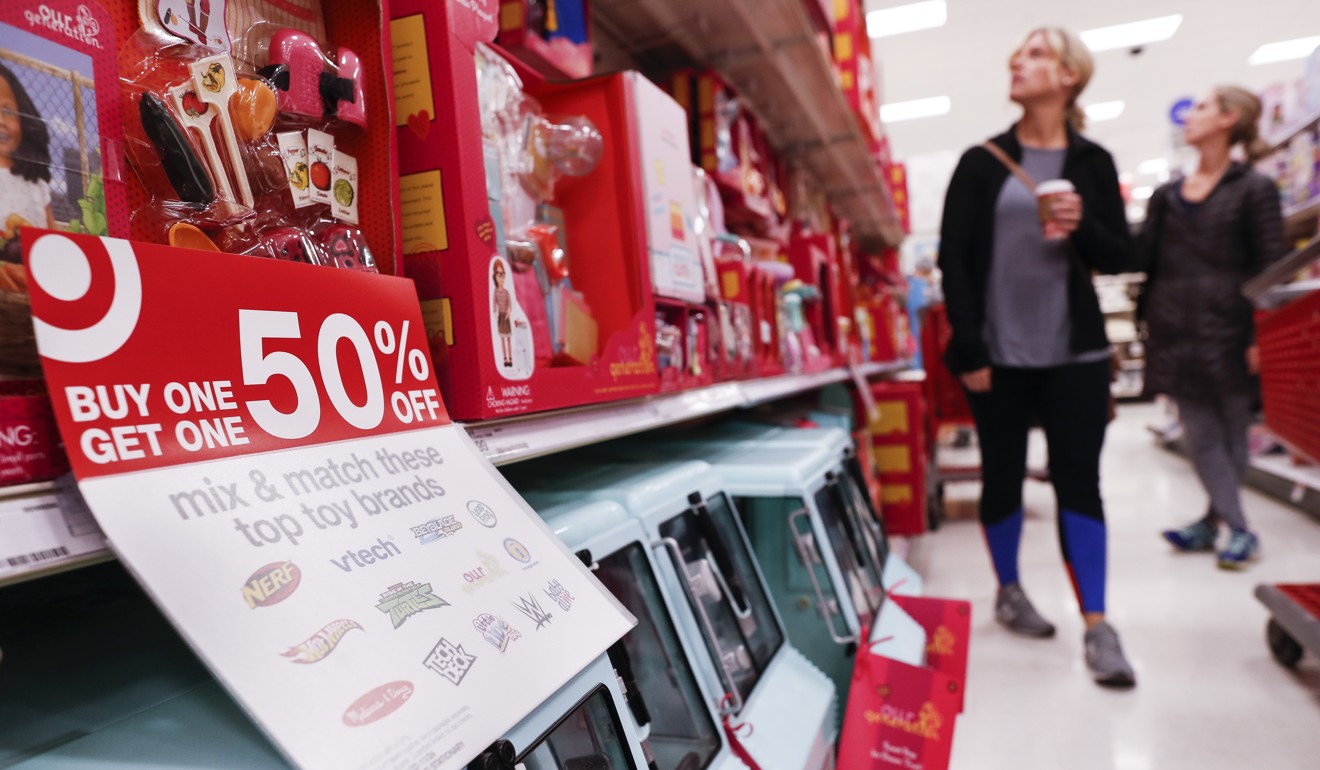
US consumers set to bear burden of Trump’s tariffs as American retailers such as Wal-Mart, Target and Best Buy weigh price hikes
- Latest tariffs could erase spending power created by last year’s tax cuts, S&P says
- UBS says levies could reduce sales by US$40 billion this year and lead to closure of 12,000 US stores
American retailers are increasingly warning consumers to brace for higher prices as the United States prepares to put tariffs on nearly all goods made in China, in the latest escalation in the trade war between the world’s two largest economies.
Over the past three weeks, some of the biggest sellers of everything from apparel to electronics in the US have expressed concern over how higher duties will affect their bottom lines and said they are preparing to pass along the increased cost to their customers.
Wal-Mart, Target and the electronics retailer Best Buy are among the shopkeepers that have said they are trying to control pricing, but customers should be prepared to spend more.
The higher costs come as the retail industry has been struggling with tighter margins and business conditions that have led to the collapse of Toys ‘R’ Us, Payless ShoeSource and Charlotte Russe in the past two years.
The question for retailers is how much of a hike consumers are willing to shoulder before they close their pocketbooks.
Consumers are ‘unequivocally the losers’ in US-China trade war, says IMF
“[Small and medium-sized businesses] tend to suffer more from tariffs and other trade barriers than large multinational firms do, with profit margins squeezed by rising costs,” S&P Global Ratings economists Beth Ann Bovino and Shaun Roache said in a research note. “To the extent that businesses can pass on these costs, consumers would see rising prices, with low-income households suffering the most.”
S&P said it expects the latest round of tariffs could increase consumer prices by 20 to 30 basis points, essentially erasing the spending power created by last year’s tax cuts in the US.
The latest round of tariffs come at a difficult time for US retailers.
Changing consumer tastes, the growth of e-commerce sales and slower traffic in malls and shopping centres have cut into sales and led to the closure of thousands of stores.
UBS warned in a research note tariffs could reduce sales by US$40 billion for retailers this year and lead to the closure of 12,000 stores in the US.
According to Coresight Research, 7,150 retail store closures have been announced in the US this year. More than 5,500 stores closed in the US last year, and 6,955 closed in 2017, Coresight said.
Trade war will have consequences for consumers and producers, says Li & Fung
The news has been mixed for retailers in the first quarter despite a 3.2 per cent spurt in domestic product growth and low unemployment in the US.
Nordstrom, JC Penney Company and Kohl’s all saw comparable store sales drops in the first three months of the year.
Bruce H. Besanko, the chief financial officer at Kohl’s, said it was “becoming more difficult to offset the cost of shipping headwind” given the tariffs and the company’s efforts to increase its top-line growth through aggressive pricing and promotions. The company said its gross margin rate is now expected to be down 20 to 30 basis points for the year.
Gap Inc., the owner of the Gap, Banana Republic and Old Navy brands, could be the latest American retailer to sound the alarm when it reports its first-quarter results on Thursday.
Shares of the country’s biggest retail chains have traded significantly lower since US President Donald Trump said this month he would raise tariffs on thousands of Chinese goods.
Gap and Nordstrom have seen their shares drop about 20 per cent; Kohl’s stock is down 27 per cent; and JC Penney’s shares have fallen more than 38 per cent.

Trump has already placed tariffs on nearly half of all Chinese goods as he tries to force Beijing to change years of industrial and trade policy that he says is unfair to foreign companies. China has responded with its own tariffs on American products.
The two sides appeared close to reaching an agreement on trade this month, but the tone shifted abruptly and the US raised tariffs from 10 per cent to 25 per cent on about US$200 billion of Chinese products. Trump and his Chinese counterpart, Xi Jinping, are expected to meet on the sidelines at the G20 summit in Osaka in June.
“To the extent that the demand for tariffed goods is inelastic, US personal income may decline due to higher prices, with possible negative knock-on effects on real activity as consumers purchase smaller amounts of other goods,” Sonia Meskin, Standard Chartered’s US economist, said in a research note.
The hit on the supply side could be higher “because lower business income and supply-chain disruption could have deleterious effects on business investment and productivity,” she said.
German firms find US less reliable than China as trading partner
The Trade Partnership, a Washington research and consulting firm, said in a report this year tariffs on all Chinese-made goods, coupled with the retaliation by Beijing on US products, could cost an American family of four as much as US$2,389 a year and shave more than 1 per cent off of US gross domestic product growth.
“But the latest tariff escalation is far too great a gamble for the US economy,” Matthew Shay, president and chief executive of the National Retail Federation, a US trade group, said. “Slapping tariffs on everything US companies import from China – goods that support US manufacturing and provide consumers with affordable products – will jeopardise American jobs and increase costs for consumers.”
As the US has added tariffs to more Chinese products, companies have been taking a variety of steps to try to control their costs and the ultimate price paid by the public.

Edward R. Rosenfeld, the CEO of shoe, handbag and accessories seller Steven Madden, said the company’s sourcing teams have moved production aggressively out of China, primarily to Cambodia. The company has also been negotiating price concessions with its Chinese suppliers.
Clifton E. Sifford, the president and CEO of Shoe Carnival, said the footwear industry was lobbying the Trump Administration not to impose the latest round of tariffs, but has also begun moving production out of China to countries in Southeast Asia as a result of the trade war.
“We are already the highest tariffed apparel industry, and it just makes absolutely no sense,” Sifford said on a conference call. “But we can't just sit back and hope that it doesn't happen, so we are making changes.”
Brian C. Cornell, the chairman and CEO of discount retailer Target, said the company made “very specific surgical decisions” to increase its inventory this year in categories, such as toys, baby and holiday items.
China consumer market ‘too big to ignore’ for foreign firms
Jeffrey Gennette, the chairman and CEO of department store chain Macy’s, said in apparel, for example, there are some brands that can demand a higher price and other items that are considered commodities. The retailer or its wholesale partner have to absorb the increased cost or risk driving away customers, he said.
“We’ve been having lots of conversations with our partners, they have with their other retail partners,” Gennette said. “If this does go through, what we're going to do? What categories are going to hold prices because we don't believe that we can sustain an increase? What areas do we believe we can and then when we don't think we can sustain an increase? Where is that burden going to be?”
Some retailers see the potential for higher prices because of tariffs as an opportunity to differentiate themselves against competitors.

“At this point, it's unclear how the industry will react with increases to apparel and shoes,” said Michael J. Hartshorn, the CFO of off-price retailer Ross Stores. “But, we certainly would not be the price increase leader in that regard. The silver lining is we have a flexible business model, and can react to the price increases and disruptions like this that historically meant to supply opportunities for off-price.”

